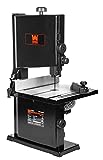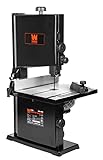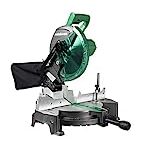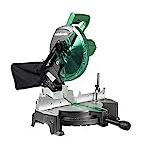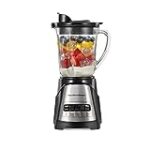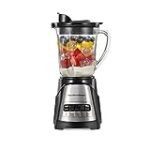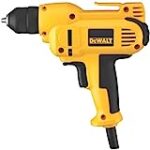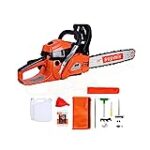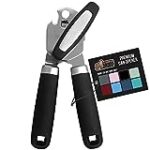🌅 Introduction
Welcome to our comprehensive band saws buying guide! If you’re in the market for a versatile and powerful cutting tool, you’ve come to the right place. Whether you’re a professional woodworker or a DIY enthusiast, a band saw is an essential addition to your workshop. In this guide, we’ll walk you through everything you need to know before making a purchase. From the different types and sizes of band saws to the key features and considerations, we’ve got you covered. So, let’s dive in and find the perfect band saw that will take your woodworking projects to the next level!
🏆 Our Top 5
- 2.8-amp motor rotates the blade up to 2500 feet per minute
- Create cuts up to 3-1/2 inches deep and 9 inches wide
- Uses 59-1/2-inch blades anywhere from 1/8 to 3/8 inches in size
- Spacious 12-1/4 x 11-7/8-inch work table bevels up to 45 degrees
- Includes a 1/4-inch-wide blade, a 2-1/2-inch dust port, a rip fence, a miter gauge, an adjustable blade guard with ball-bearing supports, and a 2-year warranty
- 3.5 amp motor creates cuts up to six inches deep and 9-3/4 inches wide
- Uses 72-inch blades anywhere from 1/8 to 1/2 inches in size
- Spacious 14-1/8 x 12-1/2 inch cast aluminum work table bevels up to 45 degrees
- Operates at two speeds of either 1520 or 2620 FPM
- Includes a 2-year warranty, a work light, a 3-in-1 dust port, a fence, a miter gauge, and a 3/8-inch blade (6 TPI)
- Includes 10-3061 Deluxe Bandsaw and 5/16 x 70-1/2 6TPI bandsaw blade|Motor: 1/2HP 5.5Amp 110V (60Hz) 1720RPM Blade Speeds: 1515 or 3280 ft/min|Table Size: 13-3/4 x 12-1/2 Table Tilt: 5 degrees left 45 degrees right|Fence Size: 12-1/4 x 2-3/8 Dust Port Size: 2-1/2 OD 2-1/4 ID Base Size: 15-7/8 W x 9-3/8 D Overall Size: 34-1/4 H x 21 W x 16-1/4 D
- POWERFUL 2.8 AMP INDUCTION MOTOR—Rip through a variety of wood materials with the 2.8 amp induction motor
- 2-SPEED DRIVE SYSTEM—Allows tool-free belt tensioning
- QUICK BLADE TENSION SETTING—Set blade tension quickly and accurately for clean cuts
- PRECISION BALL BEARING AND LOWER BLADE GUIDES—Ensure consistent tracking for accurate cutting performance
- RACK AND PINION TABLE ADJUSTMENT—Makes quick angle adjustments
- The metal band saw has 5-inch cutting capacity
- Integrated hang hook of the portable band saw allows user to hang the saw without damaging the front handle or base
- LED Work Light with 20 second delay illuminates dark work surfaces for accurate cutting of DEWALT band saw.
- Tool less blade changing lever loosens blade tension
- Variable Speed for versatility and control
🤔 How to choose?
1. Types of Band Saws
When choosing a band saw, it’s important to consider the different types available. There are three main types of band saws: benchtop, floor-standing, and portable.
– Benchtop band saws are compact and lightweight, making them ideal for small workshops or hobbyists. They are easy to move around and store when not in use.
– Floor-standing band saws are larger and more powerful, making them suitable for professional woodworkers or those who frequently work with large pieces of wood. They offer more stability and cutting capacity.
– Portable band saws are handheld and designed for cutting materials in tight spaces or on job sites. They are lightweight and easy to transport, making them a popular choice for contractors and plumbers.
2. Power and Motor Size
The power and motor size of a band saw are crucial factors to consider. The power of a band saw is measured in horsepower (HP), and it determines the cutting capacity and speed. A higher horsepower allows for cutting thicker and harder materials.
– For light-duty tasks or occasional use, a band saw with a 1/2 HP motor is sufficient.
– For medium-duty tasks or regular use, a band saw with a 1 HP motor is recommended.
– For heavy-duty tasks or professional use, a band saw with a 2 HP or higher motor is ideal.
3. Cutting Capacity and Throat Size
The cutting capacity and throat size of a band saw determine the maximum width and depth of the material that can be cut. It’s essential to choose a band saw with a cutting capacity that meets your specific needs.
– The cutting capacity is typically measured by the maximum width of the blade. For example, a band saw with a 14-inch cutting capacity can cut materials up to 14 inches wide.
– The throat size refers to the distance between the blade and the vertical frame of the band saw. A larger throat size allows for cutting larger pieces of wood.
4. Blade Size and Tension
The blade size and tension are important considerations when choosing a band saw. The blade size determines the precision and versatility of the cuts. A wider blade is more stable and suitable for straight cuts, while a narrower blade allows for intricate and curved cuts.
– The blade tension is crucial for achieving accurate and clean cuts. It ensures that the blade remains straight and doesn’t wander during the cutting process.
– It’s important to choose a band saw that allows for easy blade tension adjustment, as different materials and cuts require different levels of tension.
5. Additional Features and Accessories
Lastly, consider the additional features and accessories that come with the band saw. These can enhance the functionality and convenience of the tool. Some common features to look for include:
– **Built-in dust collection system** to keep your workspace clean and free from sawdust.
– **Quick-release blade tension lever** for easy and efficient blade changes.
– **Miter gauge** for making angled cuts.
– **Fence system** for precise and straight cuts.
– **LED work light** for improved visibility.
By considering the types of band saws, power and motor size, cutting capacity and throat size, blade size and tension, as well as additional features and accessories, you can make an informed decision when choosing a band saw that meets your specific needs and preferences. Remember to prioritize your intended use and the materials you will be working with to ensure you select the right band saw for the job.
💡 What to Look for in a band saws?
1. Blade Size and Type
When looking for a band saw, one of the most important factors to consider is the blade size and type. The blade size determines the maximum cutting capacity of the saw, so it’s crucial to choose a size that suits your needs. A wider blade allows for more stability and precision, while a narrower blade is better for intricate cuts. Additionally, the type of blade you choose will depend on the materials you plan to cut. For example, a fine-tooth blade is ideal for cutting metal, while a coarse-tooth blade is better for cutting wood.
2. Motor Power and Speed
The motor power and speed of a band saw are essential for its performance. A more powerful motor will allow you to cut through thicker and denser materials with ease. Look for a band saw with a motor power of at least 1 horsepower (HP) for general woodworking tasks. However, if you plan to work with heavy-duty materials or do a lot of resawing, consider a band saw with a higher horsepower rating. Additionally, pay attention to the speed settings of the band saw. Variable speed options are beneficial as they allow you to adjust the cutting speed according to the material you are working with.
3. Table Size and Adjustability
The table size and adjustability of a band saw are crucial for ensuring accurate and comfortable cuts. A larger table provides more support for your workpiece, allowing for better control and stability. Look for a band saw with a table that is at least 16 inches by 16 inches for versatility. Additionally, consider the table’s adjustability. A tilting table allows you to make bevel cuts, while a table that can be adjusted in height is beneficial for accommodating different workpiece sizes.
In conclusion, when purchasing a band saw, it is important to consider the blade size and type, motor power and speed, as well as the table size and adjustability. These factors will greatly impact the saw’s performance and your ability to achieve accurate and precise cuts. By carefully evaluating these features, you can ensure that you choose a band saw that meets your specific needs and allows you to tackle a wide range of woodworking projects with ease.
🔍 How we picked?
1. Types of Band Saws
When it comes to buying a band saw, it’s important to understand the different types available on the market. This knowledge will help you make an informed decision and choose the right band saw for your needs.
There are three main types of band saws: benchtop, floor-standing, and portable.
– Benchtop band saws are compact and lightweight, making them ideal for small workshops or hobbyists. They are designed to be placed on a workbench or table, providing stability and convenience. These band saws are perfect for cutting smaller materials such as thin boards or small logs.
– Floor-standing band saws are larger and more powerful, making them suitable for professional woodworkers or those who work with larger materials. They have a sturdy base and can handle heavier workloads. These band saws are perfect for cutting thick boards or large logs.
– Portable band saws are handheld and offer the flexibility to cut materials in various locations. They are lightweight and easy to transport, making them ideal for construction sites or on-the-go projects. These band saws are perfect for cutting metal pipes or rebar.
2. Key Features to Consider
When choosing a band saw, there are several key features to consider that will impact its performance and usability.
– Cutting Capacity: The cutting capacity refers to the maximum width and height of the material that the band saw can handle. It’s important to choose a band saw with a cutting capacity that meets your specific needs.
– Motor Power: The motor power determines the cutting speed and the ability to handle different materials. A more powerful motor will provide smoother and faster cuts, especially when working with hardwood or metal.
– Blade Size: The blade size determines the precision and versatility of the band saw. A wider blade allows for straighter cuts, while a narrower blade is ideal for intricate and curved cuts.
– Blade Guides: Blade guides are essential for keeping the blade aligned and reducing vibration. Look for band saws with adjustable blade guides for improved accuracy and control.
3. Safety Features
Safety should always be a top priority when using power tools, and band saws are no exception. Look for band saws that come with safety features to protect yourself and prevent accidents.
– Blade Guard: A blade guard covers the blade when not in use, preventing accidental contact and reducing the risk of injury.
– Blade Brake: A blade brake stops the blade from spinning immediately after the power is turned off, minimizing the risk of accidental contact.
– Emergency Stop Button: An emergency stop button allows you to quickly shut off the band saw in case of an emergency or if something goes wrong.
In conclusion, understanding the different types of band saws, considering key features, and prioritizing safety will help you make an informed decision when purchasing a band saw. Whether you’re a hobbyist or a professional woodworker, finding the right band saw will enhance your woodworking experience and allow you to create precise and intricate cuts.
💬 Frequently asked questions about band saws
1. What is a band saw and why should I consider buying one?
A band saw is a versatile power tool that uses a continuous band of toothed metal to cut various materials, such as wood, metal, and plastic. It offers precision and control, making it an essential tool for woodworking, metalworking, and other DIY projects. Whether you’re a professional craftsman or a hobbyist, a band saw can greatly enhance your cutting capabilities and efficiency.
2. What factors should I consider when buying a band saw?
When purchasing a band saw, there are several key factors to consider:
– **Size and capacity**: Determine the size of the materials you typically work with and choose a band saw with an appropriate throat depth and cutting height.
– **Motor power**: Look for a band saw with a motor that provides enough power for your cutting needs. Higher horsepower allows for smoother and faster cutting.
– **Blade size and type**: Consider the width and length of the blade, as well as the type of teeth it has. Different blades are designed for specific materials and cutting tasks.
– **Table size and stability**: A larger table provides more support for your workpiece, while stability ensures accurate and safe cutting.
– **Additional features**: Look for features such as adjustable speed, dust collection systems, and blade tensioning mechanisms to enhance your overall cutting experience.
3. Can a band saw replace other cutting tools in my workshop?
While a band saw is a versatile tool, it may not completely replace other cutting tools in your workshop. However, it can certainly complement and enhance your existing arsenal. For example, a band saw can make intricate curved cuts that are difficult to achieve with a table saw or circular saw. It can also handle resawing tasks more efficiently than a scroll saw. By adding a band saw to your workshop, you’ll have the ability to tackle a wider range of cutting projects with ease.
4. How do I maintain and care for my band saw?
Proper maintenance is crucial to ensure the longevity and optimal performance of your band saw. Here are a few tips:
– **Regular cleaning**: Clean the table, blade, and other components after each use to prevent debris buildup.
– **Blade tension**: Check and adjust the blade tension regularly to ensure accurate cutting and prevent premature blade wear.
– **Lubrication**: Apply lubricant to the blade and other moving parts to reduce friction and extend their lifespan.
– **Blade replacement**: Replace the blade when it becomes dull or damaged to maintain clean and precise cuts.
– **Safety precautions**: Always follow the manufacturer’s instructions and wear appropriate safety gear, such as goggles and gloves, when operating the band saw.
5. Are there any safety considerations when using a band saw?
Safety should always be a top priority when using any power tool, including a band saw. Here are a few safety considerations:
– **Blade guards**: Ensure that the blade guard is properly installed and functioning to prevent accidental contact with the blade.
– **Push sticks**: Use push sticks or other appropriate tools to keep your hands a safe distance from the blade during cutting.
– **Stable workpiece**: Secure your workpiece firmly to prevent it from moving or vibrating during cutting.
– **Proper lighting**: Ensure adequate lighting in your workspace to clearly see the cutting line and avoid potential accidents.
– **Training and experience**: Familiarize yourself with the band saw’s operation and seek proper training if necessary. Practice on scrap materials before working on important projects.
Remember, investing in a high-quality band saw that suits your specific needs and taking proper care of it will result in years of enjoyable and efficient cutting experiences.
Last update on 2024-07-24 / Affiliate links / Images from Amazon Product Advertising API
